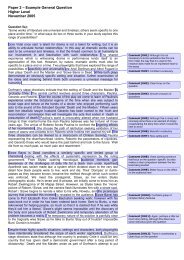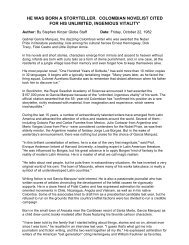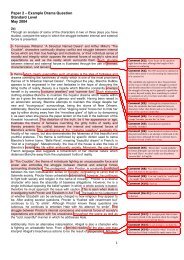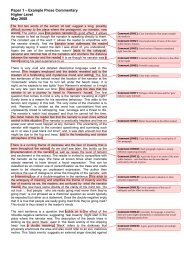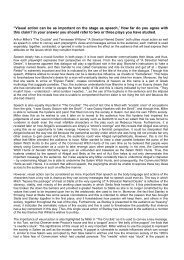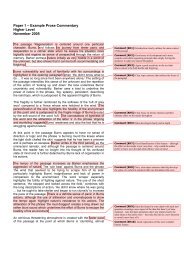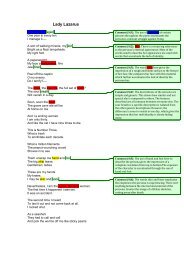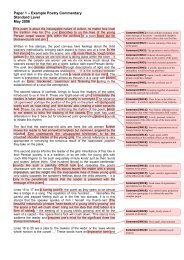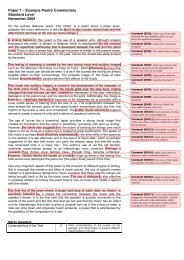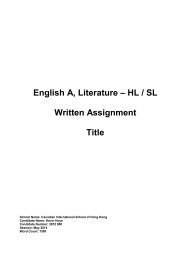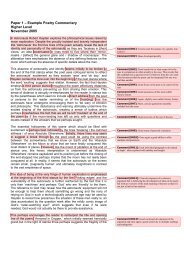Rhythm & Pace - Mr Hoye's IB English Website
Rhythm & Pace - Mr Hoye's IB English Website
Rhythm & Pace - Mr Hoye's IB English Website
- No tags were found...
Create successful ePaper yourself
Turn your PDF publications into a flip-book with our unique Google optimized e-Paper software.
wish you had never seen the sun go down! Despite the sexual tension betweenProctor and Abigail, the pace decreases, which is indicated by the absence ofexclamation marks. Furthermore, the entrance of Rebecca Nurse decreases the pace.Through theses changes in rhythm and pace, Miller emphasises the calming influencesof Proctor and Rebecca and thereby evokes sympathy towards them from theaudience. The audience thereby perceives these characters as more level headed andsensible amongst the hysteria thereby increasing the respect felt towards thesecharacters and hence further criticizing the other characters.In addition, both Miller and Williams explore the juxtaposition of calm and hysteriathrough variations of pace and rhythm. Within A Streetcar Named Desire there is adistinct change of pace between the end of scene three and the opening of scene four.During Stanleys abuse of Stella a great degree of action and events occur thusincreasing the pace. Furthermore, the sound of a blow and Stellas cry in conjunctionwith the ubiquitous exclamation marks within Blanches speech in phrases such as Iwant my sisters clothes! Well go to that woman upstairs! the pace is dramaticallyincreased thereby attracting the attention of the audience and heightening their fear forStella. This is juxtaposed with the opening of scene four during which the pacedecreases and Stella is described as having an almost narcotized tranquility. Thisdirect contrast of calm and hysteria serves to emphasise and draw the audiencesattention to the difference between the two and instill a sense of hopelessness anduneasiness within the audience.Similarly, within Act III of The Crucible there is a constant juxtaposition of calm andhysteria as Proctors influence serves to decrease the pace of Abigails cries andCoreys disbelief. This oscillation between calm and hysteria constantly changes therhythm of the play thereby maintaining the attention of the audience and ensuring theyremain enrapt.Moreover, although both Miller and Williams use pace to alter the level of tension it isapparent that there is no clear correlation between the pace of a scene and the level oftension evoked within the audience. Within A Streetcar Named Desire the fast paceand, to an extent, immediate nature of Stanleys rape of Blanche reflects the manner inwhich a fast pace can induce a feeling of high tension. Blanches repetition of the wordOh! in response to Stanleys accusations results in a fast paced dialogue between thetwo and may serve to evoke sympathy towards Blanche from the audience due to thefact that she is effectively rendered helpless. Furthermore Blanches hysterical cries ofStay back! and Some awful thing will happen! It will! are filled with relatively shortphrases with exclamation marks thereby increasing the pace as well as the tension feltby the audience.In contrast, arguably the pivotal moment of The Crucible, when Elizabeth agonisesover whether to betray Proctor as a lecher is one of the slowest paced moments in theplay. Throughout Elizabeths speech there is the presence of breaks or dashes forexample when she states She were - before glanc[ing] at Proctor for a cue] and He -as well as Abigail Williams - The presence of the dashes indicates a change in pacefrom the frantic accusations preceding it and the slow moving nature of the scenewould be perceived by the audience through Elizabeths constant glancing at Proctorfor guidance. This slow moving pace also serves to attract the attention of the audienceas it maintains a level of suspense and, hence, increases tension as the fate of manycharacters rests on Elizabeths reply.Furthermore, the structure of the plays serves more clearly to alter the interest of theaudience. The Crucible is seen to have a somewhat regular rhythm with each actbuilding up to and ending on a tense moment. This is evident within Act II as the actfocuses upon the relationship between Elizabeth and Proctor thus inducing feelings ofnormality amongst the audience. However, upon Cheevers arrival at the end of the actto take Elizabeth the sense of normality is disrupted and the pace increases, theaudiences attention is thus attracted as Proctor proclaims Now Hell and Heavengrapple on our backs and all our old pretence is ripped away.Comment [K15]: There is anover-reliance on exclamation marksas evidence in this essay.Comment [K16]: True however alink needs to be made between thisand interest. Perhaps our sympathyfor these characters captures ourattentionComment [K17]: This time awhole linking phrase is used toindicate that the essay is moving onto consider a second point this isthe second point from theintroduction excellent structureComment [K18]: Clear link backto the questionComment [K19]: Connective tojoin ideas within a given pointComment [K20]: Some lovelyvocabularyComment [K21]: Another linkingphrase to introduce a new point thethird point from the introductionComment [K22]: This is a nicecomplex point that high pace doesnot necessarily equal high tensionbecause slow paced scenes can createequally high levels of tension andaudience interestComment [K23]: Multiplequotations to support pointsComment [K24]: Again linkingphrase to introduce the final point inthe essay, which was also the finalpoint in the introduction



